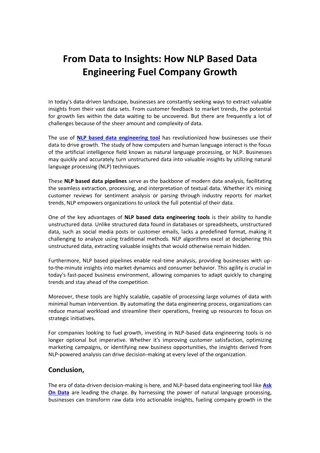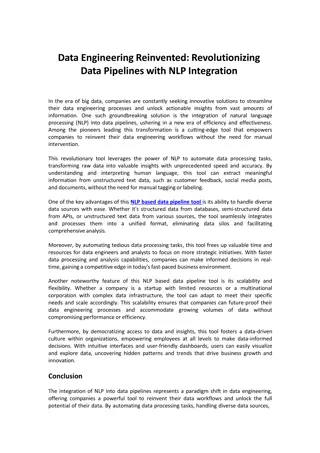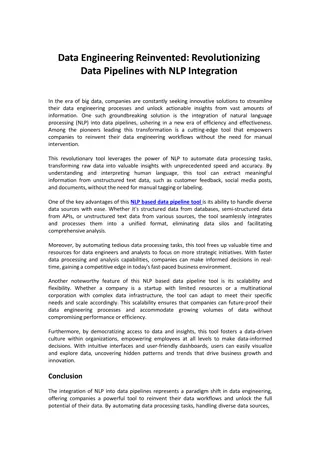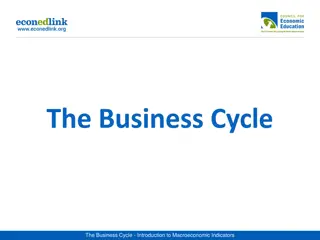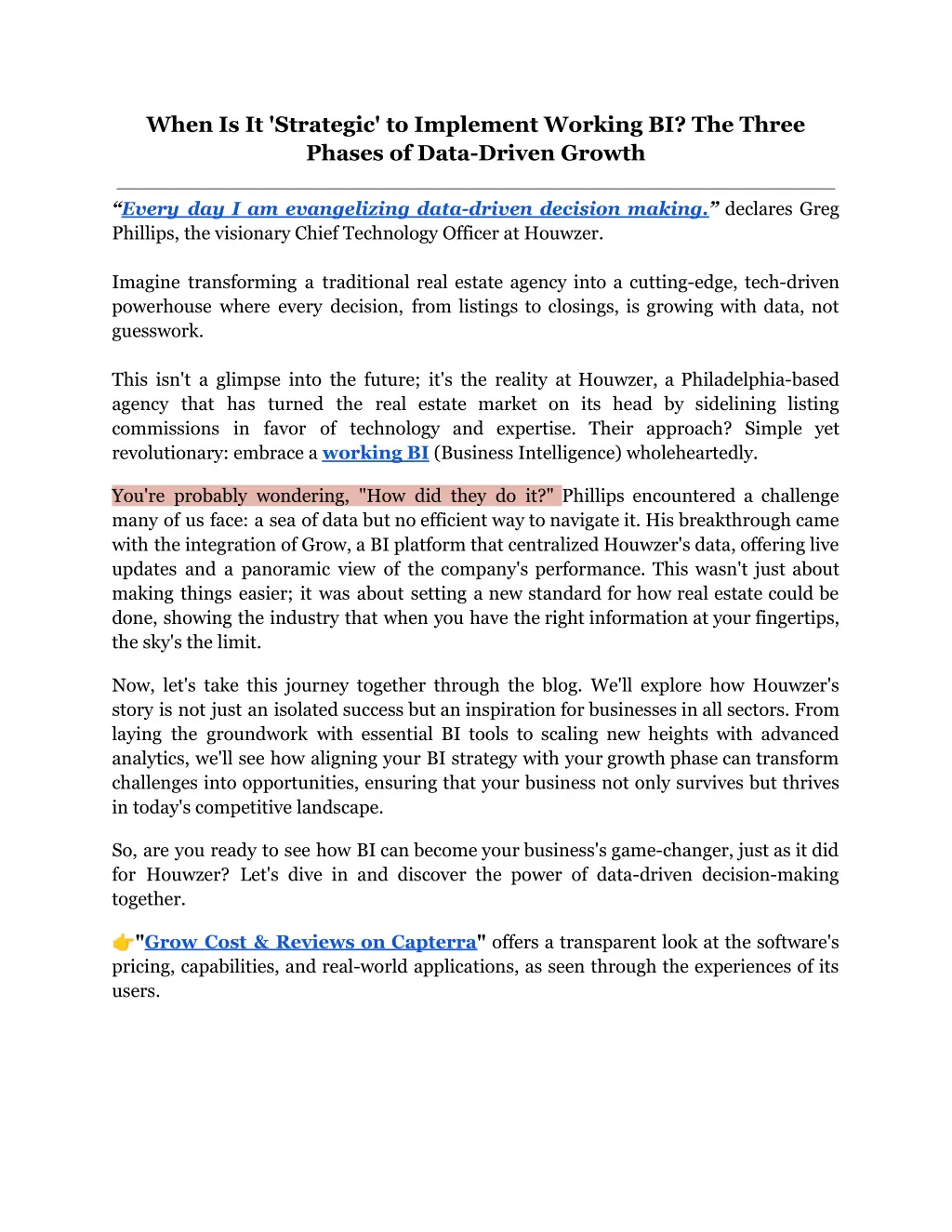
When Is It 'Strategic' to Implement Working BI_ The Three Phases of Data-Driven Growth
nExplore the strategic timing for implementing working BI across the three phases of data-driven growth. Learn when to lay the foundation, expand capabilities, and innovate with BI solution to transform your business.
- best Business Intelligence software
- working BI
- Business Intelligence software companies
- BI solution
- BI software
Download Presentation

Please find below an Image/Link to download the presentation.
The content on the website is provided AS IS for your information and personal use only. It may not be sold, licensed, or shared on other websites without obtaining consent from the author. Download presentation by click this link. If you encounter any issues during the download, it is possible that the publisher has removed the file from their server.
E N D
Presentation Transcript
When Is It 'Strategic' to Implement Working BI? The Three Phases of Data-Driven Growth Every day I am evangelizing data-driven decision making. declares Greg Phillips, the visionary Chief Technology Officer at Houwzer. Imagine transforming a traditional real estate agency into a cutting-edge, tech-driven powerhouse where every decision, from listings to closings, is growing with data, not guesswork. This isn't a glimpse into the future; it's the reality at Houwzer, a Philadelphia-based agency that has turned the real estate market on its head by sidelining listing commissions in favor of technology and expertise. Their approach? Simple yet revolutionary: embrace a working BI (Business Intelligence) wholeheartedly. You're probably wondering, "How did they do it?" Phillips encountered a challenge many of us face: a sea of data but no efficient way to navigate it. His breakthrough came with the integration of Grow, a BI platform that centralized Houwzer's data, offering live updates and a panoramic view of the company's performance. This wasn't just about making things easier; it was about setting a new standard for how real estate could be done, showing the industry that when you have the right information at your fingertips, the sky's the limit. Now, let's take this journey together through the blog. We'll explore how Houwzer's story is not just an isolated success but an inspiration for businesses in all sectors. From laying the groundwork with essential BI tools to scaling new heights with advanced analytics, we'll see how aligning your BI strategy with your growth phase can transform challenges into opportunities, ensuring that your business not only survives but thrives in today's competitive landscape. So, are you ready to see how BI can become your business's game-changer, just as it did for Houwzer? Let's dive in and discover the power of data-driven decision-making together. ?"Grow Cost & Reviews on Capterra" offers a transparent look at the software's pricing, capabilities, and real-world applications, as seen through the experiences of its users.
Understanding the Strategic Importance of BI BI is not merely about generating reports; it's about making informed decisions that steer the company toward its goals. Strategic BI solution offers a comprehensive view of an organization's data, enabling leaders to predict trends, optimize operations, and outmaneuver competitors. Businesses that recognize the strategic value of BI software not only stay ahead of the curve but also innovate and grow in ways previously unimaginable. Phase 1: Foundation Building The journey towards becoming a data-driven organization commences with the foundational phase. This initial step involves the integration of basic BI tools for efficient data collection and analysis. Establishing a robust data infrastructure is paramount during this phase, involving the implementation of data warehousing, data lakes, and other data management solutions. These systems serve as the backbone of a working BI strategy, ensuring data is not only collected but also organized, secured, and made accessible for analysis.
Business Intelligence software companies play a critical role in this phase by offering solutions that simplify the complexities of data management and analysis. The primary goal here is to lay the groundwork for advanced analytics, ensuring that the organization has a solid base of reliable data. This phase is crucial for understanding market trends, customer behavior, and operational efficiency. By leveraging BI software, businesses can begin to make sense of the vast amounts of data they collect, turning raw data into actionable insights. Phase 2: Expansion and Integration As organizations mature in their data journey, the next phase involves the expansion of BI capabilities to encompass more sophisticated analytics, such as predictive modeling and AI integration. This phase marks a significant step up from basic reporting and data analysis, moving towards predictive insights that can inform strategic decisions. The expansion of BI capabilities necessitates the integration of data across departments, breaking down silos and leading to a more cohesive, data-driven culture. This cross-departmental integration is facilitated by advanced BI solutions, which enable seamless data sharing and analysis across the organization. The best Business Intelligence software offers tools for data visualization, advanced analytics, and collaborative features that empower teams to work together more effectively. A notable example of a business that successfully navigated this phase is a retail company that implemented an advanced BI solution to integrate sales, inventory, and customer data across its online and brick-and-mortar operations. This integration provided a comprehensive view of the business, enabling the company to optimize inventory management, tailor marketing strategies to customer preferences, and ultimately achieve significant growth. Phase 3: Optimization and Innovation The pinnacle of the data-driven growth journey is the optimization and innovation phase. At this stage, businesses are not just using BI to support decision-making; they are leveraging advanced analytics, real-time data processing, and custom BI solutions to drive innovation and strategic initiatives. This advanced stage of BI implementation allows businesses to respond more quickly to market changes, anticipate customer needs, and develop new products and services. The use of real-time data processing enables organizations to gain immediate insights into their operations, allowing for swift adjustments and optimizations.
Businesses leveraging BI for strategic initiatives often engage in new product development, market expansion, and exploring new business models. For instance, a manufacturing company might use predictive analytics to anticipate equipment failures and schedule maintenance, thereby reducing downtime and increasing productivity. Similarly, a service-oriented business might analyze customer interaction data to identify new service opportunities or improve customer satisfaction. Identifying Your Organization's Phase Insights on Assessing Your Data-Driven Growth Phase To determine your organization's current phase in the data-driven journey, consider how you currently leverage data. Are you in the initial stages of simply collecting data, or have you moved beyond to analyze, predict, and innovate based on that data? Understanding your phase helps in tailoring your BI strategy effectively. Self-Assessment Checklist/Framework 1. Data Collection and Management: Are your data collection methods systematic? Do you have a centralized system like a data warehouse or lake? 2. Analytics and Reporting: Have you moved beyond basic reporting? Are you using data to generate insights that inform decision-making? 3. Predictive Analytics and AI: Are you utilizing advanced analytics, including predictive modeling and AI, to forecast trends and automate decisions? 4. Innovation and Strategic Use: Is your BI being used to drive new product development, enter new markets, or significantly alter your business model? Importance of Aligning BI Strategy Aligning your BI strategy with your growth phase ensures that your efforts in BI are both effective and efficient. For instance, a company in the foundational phase should focus on establishing a solid data infrastructure before diving into advanced analytics or AI. Strategic Implementation of BI Actionable Strategies for BI Implementation Each phase requires a tailored approach:
Foundation Building: Prioritize establishing a robust data infrastructure. Choose BI software that is scalable and user-friendly to ensure a solid base for future growth. Expansion and Integration: Expand your BI capabilities to include more sophisticated analytics. Focus on integrating data across departments to break down silos and foster a unified approach to data analysis. Optimization and Innovation: Leverage advanced analytics and real-time data processing. Consider custom BI solutions to address specific business needs and drive innovation. Importance of Stakeholder Buy-In, Training, and Culture Shift Successful BI implementation is not just about technology; it's about people. Securing stakeholder buy-in, investing in comprehensive training, and nurturing a culture that values data-driven decision-making are crucial steps. These efforts ensure that the BI solution is not only accepted but also effectively utilized across the organization. Highlighting Common Pitfalls and How to Avoid Them Underestimating the Importance of Data Quality: Ensure your data is clean and reliable. Bad data quality can cause insights and choices that aren't based on facts. Overlooking User Adoption: BI tools must be user-friendly. Invest in training and change management to boost adoption rates. Failing to Scale: Choose BI software that can grow with your business. The best Business Intelligence software is not just powerful but also scalable. Conclusion As we navigate through the transformative narrative of Houwzer and the insightful leadership of Greg Phillips, we arrive at the conclusion: understanding the "when" in the strategic implementation of a working BI. The journey of data-driven growth is not linear but phased, each stage revealing not just new challenges but also opportunities for leveraging BI to its fullest potential. When is it strategic to implement working BI? The answer lies within the three distinct phases of data-driven growth: 1. Foundation Building: The inception phase where the groundwork is laid. For startups and companies in their nascent stages, this is the 'when.' When you're setting up your data infrastructure, establishing basic data collection and analysis practices this is the time to embed BI into the very fabric of your business
operations. Its not just about adopting technology; its about cultivating a mindset that values data from day one. 2. Expansion and Integration: As your business grows and complexities increase, the need for sophisticated analytics becomes apparent. This is your 'when' for expanding BI capabilities. When you start to see data silos forming, when the limitations of manual decision-making, that's your cue. Integrating advanced BI solutions during this phase enables a seamless flow of information, breaking down silos and fostering a data-driven culture that scales with your business. 3. Optimization and Innovation: implementation of BI is centered on optimization and innovation. This is the 'when' for leveraging real-time data processing, predictive analytics, and AI-driven insights to not just respond to market changes but anticipate them. When your business seeks to redefine its market, enter new territories, or launch innovative products, BI becomes your compass, guiding strategic initiatives with data-backed confidence. reporting become a bottleneck for For mature businesses, the strategic The strategic timing of BI implementation is the key. Just as Houwzer identified its 'when' and harnessed BI to revolutionize real estate brokerage, your business too has its unique timing. Grow, the best Business Intelligence software, helps you in recognizing this timing knowing when to lay the foundation, when to expand, and when to innovate is key to unlocking the transformative power of BI. Grow platform ensures that BI implementation is not just a technical exercise but a strategic endeavor that aligns with your business's growth phase, driving efficiency, fostering innovation, and ultimately, leading the charge in a competitive landscape. As we conclude our journey, let's carry forward the lesson that the 'when' of implementing working BI is as crucial as the 'how.' It's about making BI a core part of your business strategy, tailored to each phase of your growth. With Grow's 14-day free trial, now is the time to ask yourself, "When is my BI moment?" Move forward with confidence, led by data-driven insights.

